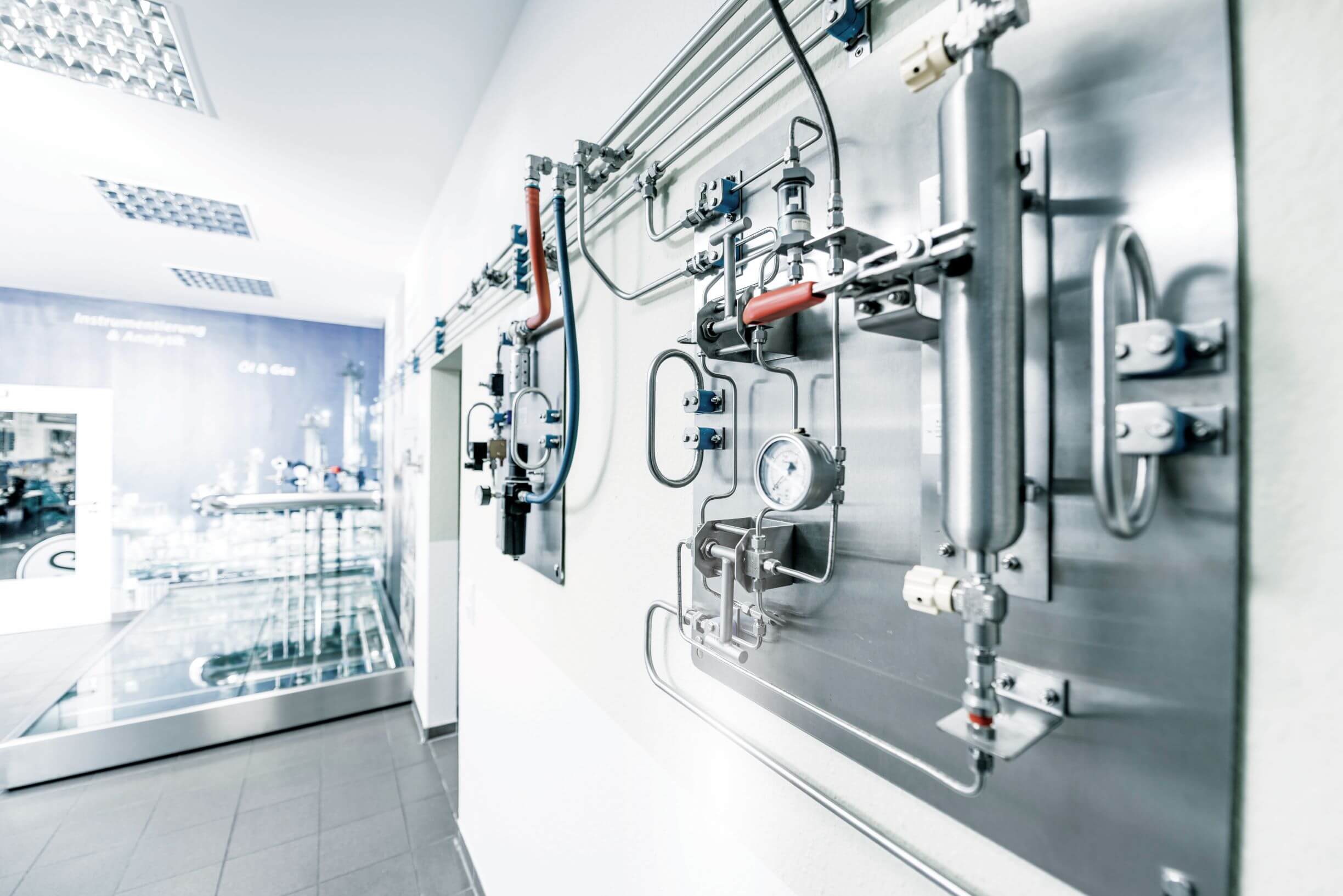Share this
Ensure Your Gas Bomb Sampling Procedure Doesn’t Fall Short in Northern California
by Morgan Zealear on 7/1/21 12:30 PM

A gas sample bomb, or gas sample cylinder, is a container specifically designed to collect and store high-pressure gas samples to be transported to a laboratory or analyzer for analysis. While procedures vary from one sampling station to another, gas bomb sampling procedures are typically quite simple: open the valve to provide continuous flow through the sample station, hook up the sample bomb, take the sample, close the sample bomb, and take it to the laboratory for analysis.
Despite the simplicity of the procedure, there are a number of issues that may present and lead to inconsistent or misrepresentative samples, such as:
- Improper transportation of gas sample
- Inadequate flow-through sample line
- Insufficient panel design
- Improperly prepared sample bombs
Obtaining a consistent gas bomb sample is critical for ensuring process and quality control in Northern California refineries and meeting regulatory requirements from the EPA. Let’s take a look into common gas bomb sampling issues and how to improve sampling procedures to enhance sampling reliability.
Common Gas Bomb Sampling Procedure Issues
In my years working with Northern California refineries, I have come across a plethora of gas bomb sampling procedure issues that lead to poor sampling reliability. However, the most common issues circle back to improper transportation of gas, inadequate flow-through sample lines, insufficient panel designs within sample stations, and improperly prepared sample bombs.
Improper Gas Transport
Gas behavior changes as temperature and pressure in sampling systems change. If measures are not taken to heat the sample line or reduce the pressure, the result may be transporting the gas at its dew point temperature. As gases approach or reach their dew point temperature, they become saturated and are likely to condense which may lead to a misrepresentative sample.
Inadequate Flow-Through Sample Transport Line
Inadequate flow-through sample lines can cause inconsistent gas samples to be obtained. Inadequate flow may be the result of:
- Excessive length of transport line from the sample point to sampling panel and sample bomb
- Bent or crimped tubing or piping
- Dead legs in the sample transport line
- Leaks in tubing or piping
The above issues can lead to an insufficient sample volume and may result in a misrepresentative sample or the inability to analyze.
Insufficient Panel Design
Gas sampling panels should be designed to promote proper procedures for operation. When gas panels are not intuitively laid out or do not have clearly printed instructions, this can lead to inconsistent gas bomb sampling procedures and thus, inconsistent results. Such inconsistencies may also stem from a lack of sampling station standardization throughout a refinery. With varying sampling panel layouts and procedures, there is a higher chance of sampling errors and inconsistencies. A well-designed gas sampling panel should result in consistent sampling procedures and results, regardless of the individual obtaining the sample.
Improperly Prepared Sample Bombs
One of the most important factors for obtaining a representative sample is the use of a clean and properly prepared sample bomb. However, it is all too often that Northern California refineries maintain a low supply of sample bombs which can lead to engineers taking shortcuts and using a contaminated sample bomb.
If sample bombs are not properly cleaned, gas from a previous measurement will remain in the cylinder and will mix with the new sample. This is a sure way to obtain a misrepresentative sample.
If the purpose of the sample is to comply with local environmental or air quality regulations, the lack of a representative sample can lead to fines or sanctions from regulatory bodies. If the sample is intended to inform refinery processes, this could lead to serious process control issues. If the sample was to verify the composition of a gas to be used in calibration, the result could be a poorly calibrated piece of equipment. Improper preparation of sample bombs can also lead to product quality control issues.
Improving Gas Bomb Sampling Procedures Through Local Vendors
Through my experience with gas bomb sampling procedures, I have found that one of the most prevalent issues leading to inconsistent samples is the shortage of sample bombs in Northern California refineries. Representative samples are critical in refineries for informing processes, meeting regulatory requirements, and maintaining quality control. In addition to proper preparation and cleaning, It is important to have enough ready-to-use sample bombs to avoid mistakes leading to contamination of new samples with old samples.
Swagelok Northern California has worked extensively with local refineries to achieve reliable and consistent sampling. Our Field Engineers have extensive knowledge of gas sampling applications in refineries and can provide onsite consultations to determine the ideal gas sample bomb for your use case.
To find out more about how Swagelok Northern California can help improve your gas bomb sampling procedures, contact our team today by calling 510-933-6200.
 Morgan Zealear | Product Engineer – Assembly Services
Morgan Zealear | Product Engineer – Assembly Services
Morgan holds a B.S. in Mechanical Engineering from the University of California at Santa Barbara. He is certified in Section IX, Grab Sample Panel Configuration, and Mechanical Efficiency Program Specification (API 682). He is also well-versed in B31.3 Process Piping Code. Before joining Swagelok Northern California, he was a Manufacturing Engineer at Sierra Instruments, primarily focused on capillary thermal meters for the semiconductor industry (ASML).
Share this
- Archive (465)
- Assembly Services (207)
- About (100)
- Seal Support Systems (96)
- Best Practices (88)
- Training Services (74)
- Fittings (51)
- Semiconductor Applications (49)
- Hoses and Flexible Tubing (47)
- Regulators (44)
- Tubing (42)
- Grab Sampling Systems (32)
- Sampling Systems (32)
- Gas Systems (30)
- Services (30)
- Downloads (29)
- Valves (24)
- Application Support (18)
- Orbital Welding (17)
- Case Studies (13)
- Steam Systems (13)
- Frequently Asked Questions (12)
- Tools (12)
- Measurement Devices (7)
- Subsystems (6)
- Thermal Management (6)
- September 2023 (1)
- August 2023 (2)
- June 2023 (1)
- March 2023 (3)
- February 2023 (3)
- January 2023 (4)
- December 2022 (4)
- November 2022 (4)
- October 2022 (4)
- September 2022 (1)
- August 2022 (3)
- July 2022 (2)
- June 2022 (4)
- May 2022 (1)
- April 2022 (2)
- March 2022 (1)
- February 2022 (2)
- January 2022 (3)
- December 2021 (1)
- November 2021 (6)
- October 2021 (6)
- September 2021 (8)
- August 2021 (4)
- July 2021 (3)
- June 2021 (6)
- May 2021 (6)
- April 2021 (7)
- March 2021 (5)
- February 2021 (4)
- January 2021 (6)
- December 2020 (5)
- November 2020 (6)
- October 2020 (6)
- September 2020 (8)
- August 2020 (7)
- July 2020 (8)
- June 2020 (8)
- May 2020 (6)
- April 2020 (9)
- March 2020 (7)
- February 2020 (10)
- January 2020 (21)
- December 2019 (23)
- November 2019 (21)
- October 2019 (22)
- September 2019 (21)
- August 2019 (22)
- July 2019 (23)
- June 2019 (20)
- May 2019 (23)
- April 2019 (22)
- March 2019 (21)
- February 2019 (20)
- January 2019 (21)
- December 2018 (14)
- November 2018 (19)
- October 2018 (23)
- September 2018 (17)
- August 2018 (29)
- July 2018 (11)
- June 2018 (6)
- May 2018 (5)
- April 2018 (4)
- March 2018 (5)
- February 2018 (3)
- January 2018 (3)
- December 2017 (2)
- November 2017 (4)
- October 2017 (3)
- September 2017 (2)
- August 2017 (6)
- July 2017 (4)
- June 2017 (4)
- May 2017 (4)
- April 2017 (3)
- March 2017 (4)
- February 2017 (3)
- January 2017 (3)
- December 2016 (3)
- November 2016 (3)
- October 2016 (3)
- September 2016 (5)
- August 2016 (5)
- July 2016 (4)
- June 2016 (5)
- May 2016 (3)
- April 2016 (4)
- March 2016 (5)
- February 2016 (11)
- January 2016 (1)
- December 2015 (3)
- November 2015 (4)
- October 2015 (3)
- September 2015 (4)
- August 2015 (4)
- July 2015 (8)
- June 2015 (5)
- May 2015 (3)
- April 2015 (4)
- March 2015 (4)
- February 2015 (3)
- January 2015 (4)
- December 2014 (2)
- November 2014 (3)
- October 2014 (4)
- September 2014 (4)
- August 2014 (4)
- July 2014 (5)
- June 2014 (4)
- May 2014 (4)
- April 2014 (5)
- March 2014 (4)
- February 2014 (3)
- January 2014 (4)
- December 2013 (5)
- November 2013 (3)
- October 2013 (4)
- September 2013 (3)
- August 2013 (5)
- July 2013 (5)
- June 2013 (5)
- May 2013 (3)
- April 2013 (6)
- March 2013 (4)
- February 2013 (4)
- January 2013 (8)
- December 2012 (4)
- November 2012 (6)
- October 2012 (6)
- September 2012 (4)
- August 2012 (4)
- July 2012 (4)
- June 2012 (4)

.webp?width=210&height=70&name=StickyLogo%20(5).webp)